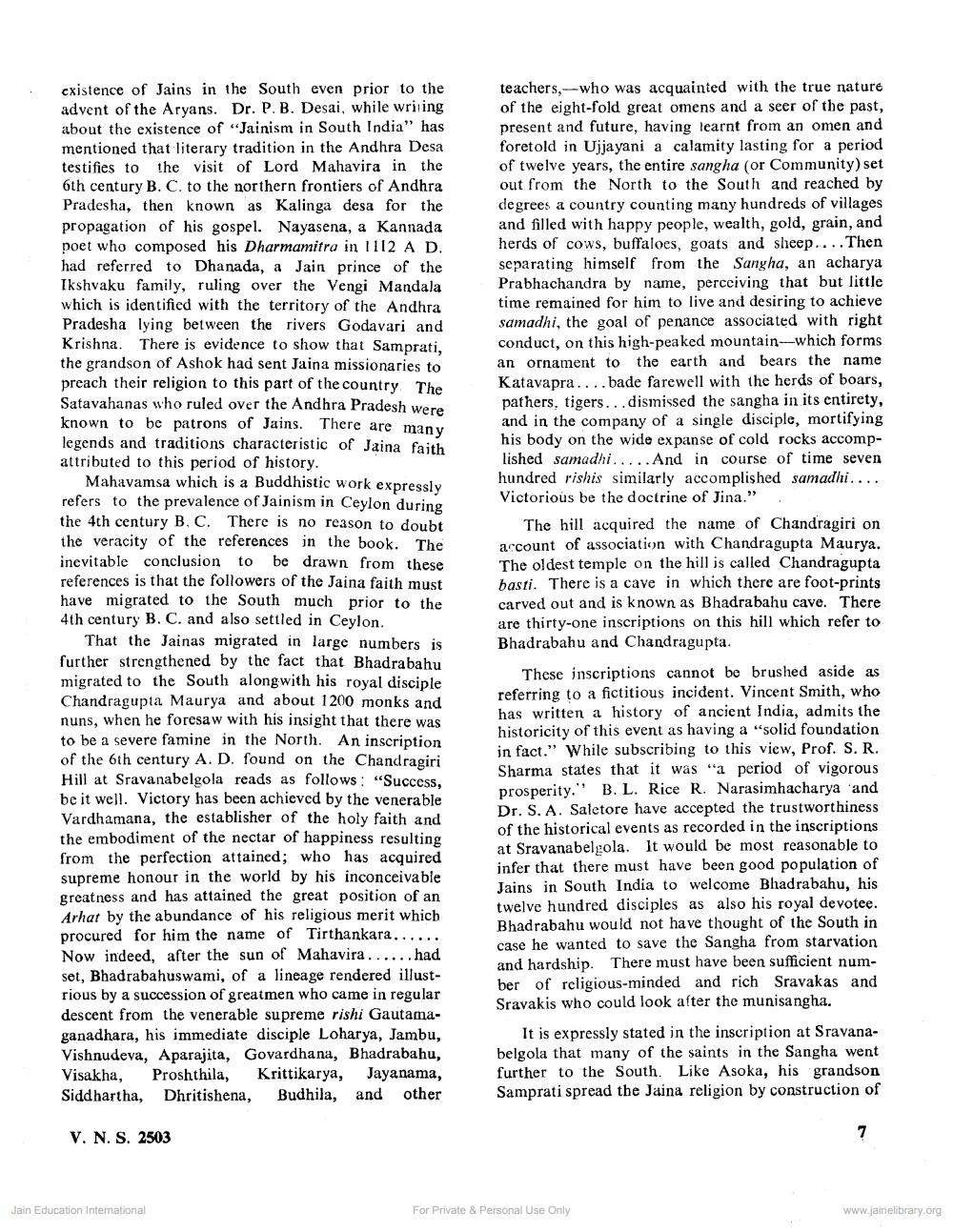Book Title: Jainism in South India Author(s): T K Tukol Publisher: Z_Rajendrasuri_Janma_Sardh_Shatabdi_Granth_012039.pdf View full book textPage 2
________________ cxistence of Jains in the South even prior to the advent of the Aryans. Dr. P. B. Desai, while writing about the existence of "Jainism in South India" has mentioned that literary tradition in the Andhra Desa testifies to the visit of Lord Mahavira in the 6th century B. C. to the northern frontiers of Andhra Pradesha, then known as Kalinga desa for the propagation of his gospel. Nayasena, a Kannada poet who composed his Dharmamitra in 1112 A D. had referred to Dhanada, a Jain prince of the Ikshvaku family, ruling over the Vengi Mandala which is identified with the territory of the Andhra Pradesha lying between the rivers Godavari and Krishna. There is evidence to show that Samprati, the grandson of Ashok had sent Jaina missionaries to preach their religion to this part of the country The Satavahanas who ruled over the Andhra Pradesh were known to be patrons of Jains. There are many legends and traditions characteristic of Jaina faith attributed to this period of history. Mahavamsa which is a Buddhistic work expressly refers to the prevalence of Jainism in Ceylon during the 4th century B. C. There is no reason to doubt the veracity of the references in the book. The inevitable conclusion to be drawn from these references is that the followers of the Jaina faith must have migrated to the South much prior to the 4th century B. C. and also settled in Ceylon. That the Jainas migrated in large numbers is further strengthened by the fact that Bhadrabahu migrated to the South along with his royal disciple Chandragupta Maurya and about 1200 monks and nuns, when he foresaw with his insight that there was to be a severe famine in the North. An inscription of the 6th century A. D. found on the Chandragiri Hill at Sravanabelgola reads as follows: "Success, be it well. Victory has been achieved by the venerable Vardhamana, the establisher of the holy faith and the embodiment of the nectar of happiness resulting from the perfection attained; who has acquired supreme honour in the world by his inconceivable greatness and has attained the great position of an Arhat by the abundance of his religious merit which procured for him the name of Tirthankara...... Now indeed, after the sun of Mahavira ...... had set, Bhadrabahuswami, of a lineage rendered illustrious by a succession of greatmen who came in regular descent from the venerable supreme rishi Gautamaganadhara, his immediate disciple Loharya, Jambu, Vishnudeva, Aparajita, Govardhana, Bhadrabahu, Visakha, Proshthila, Krittikarya, Jayanama, Siddhartha, Dhritishena, Budhila, and other teachers, who was acquainted with the true nature of the eight-fold great omens and a seer of the past, present and future, having learnt from an omen and foretold in Ujjayani a calamity lasting for a period of twelve years, the entire sangha (or Community) set out from the North to the South and reached by degrees a country counting many hundreds of villages and filled with happy people, wealth, gold, grain, and herds of cows, buffaloes, goats and sheep.... Then separating himself from the Sangha, an acharya Prabhachandra by name, perceiving that but little time remained for him to live and desiring to achieve samadhi, the goal of penance associated with right conduct, on this high-peaked mountain--which forms an ornament to the earth and bears the name Katavapra....bade farewell with the herds of boars, pathers, tigers... dismissed the sangha in its entirety, and in the company of a single disciple, mortifying his body on the wide expanse of cold rocks accomplished samadhi..... And in course of time seven hundred rishis similarly accomplished samadhi.... Victorious be the doctrine of Jina." The hill acquired the name of Chandragiri on account of association with Chandragupta Maurya. The oldest temple on the hill is called Chandragupta basti. There is a cave in which there are foot-prints carved out and is known as Bhadrabahu cave. There are thirty-one inscriptions on this hill which refer to Bhadrabahu and Chandragupta. These inscriptions cannot be brushed aside as referring to a fictitious incident. Vincent Smith, who has written a history of ancient India, admits the historicity of this event as having a “solid foundation in fact." While subscribing to this view, Prof. S. R. Sharma states that it was a period of vigorous prosperity."' B. L. Rice R. Narasimhacharya and Dr. S. A. Saletore have accepted the trustworthiness of the historical events as recorded in the inscriptions at Sravanabelgola. It would be most reasonable to infer that there must have been good population of Jains in South India to welcome Bhadrabahu, his twelve hundred disciples as also his royal devotee. Bhadrabahu would not have thought of the South in case he wanted to save the Sangha from starvation and hardship. There must have been sufficient number of religious-minded and rich Sravakas and Sravakis who could look after the munisa ngha. It is expressly stated in the inscription at Sravanabelgola that many of the saints in the Sangha went further to the South Like Asoka, his grandson Samprati spread the Jaina religion by construction of V. N. S. 2503 Jain Education International For Private & Personal Use Only www.jainelibrary.orgPage Navigation
1 2 3 4 5 6
